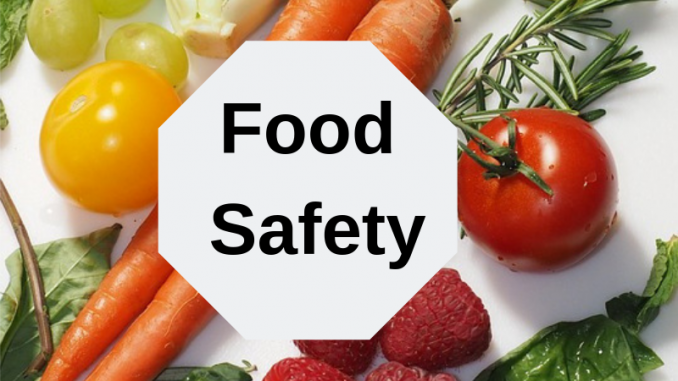
Table of Contents
What is Food Safety?
- Food safety is the absence, or safe, acceptable levels, of hazards in food that may harm the health of consumers.
- It refers to limiting the presence of those hazards whether chronic or acute, that may make food injurious to the health of the consumer.
- Food safety refers to the process of reducing harmful impact of food-borne illnesses through maintaining hygiene and sanitation during harvest, processing, storage, distribution, all the way to preparation and consumption.
- Food safety is increasing in magnitude as a public health concern for health practitioners and the general public.
- Food safety is one of the crucial global concerns that covers variety of different areas of daily life for health and well-being.
- The “World Health Organization (WHO) five keys to safer food” serve as the basis for educational programs to train food handlers and educate the consumers. They are especially important in preventing food-borne illness.
WHO Five Keys to Safer Food are:
- Keep food surfaces clean. Wash all utensils, plates, platters, and cutlery as soon as used.
- Separate raw food from cooked food.
- Cook food thoroughly, to the appropriate temperature.
- Keep food at safe temperatures, both for serving and storage.
- Use safe water and raw materials.
When Should We Check Food Safety?
Under general condition, as a food handler:
- Food safety should be checked and ensured at regular interval of time.
- It should be checked at all points of production, preparation, handling, storage, transportation and cooking.
- Moreover, foods vulnerable to contamination should be meticulously assessed in short time intervals.
However, legally:
- Local authorities are accountable for enforcing food hygiene laws and can inspect any business at any point in the food production and distribution process.
- Authorized officers from the local council will check whether the business is complying with food law and producing food that is safe to eat.
Ways to Check Food Safety:
Inspections
- Location
- How do staffs work
- Company food safety management system
- The types of food prepared
Authorized officers may visit the premises for several reasons, including:
- Food hygiene and food standards inspections
- Sampling of food
- Complaint follow-up
- Advisory visits
They have the right to enter and inspect the premises at any reasonable time as per the government norms and legal procedures. However, the authorized officers usually arrive without making an appointment.
Importance/Necessity of Food Safety
- To ensure the provision of food security
- To reduce health costs occurring due to food related diseases
- To reduce risk of food-borne diseases.
- To prevent health illnesses
- To preserve the quality of food.
Who Are More Affected by Poor Food Safety?
Although anyone can get a food-borne illness, some people are at greater risk and more affected by poor food safety. They are:
- Children younger than age 4 of age.
- They have the highest incidence of laboratory-confirmed infections from some foodborne pathogens including Campylobacter, Cryptosporidium, Salmonella, Shigatoxin-producing Escherichia coli, Shigella, and Yersinia.
- People older than age 50 and those with reduced immunity
- They are at greater risk for hospitalizations and death from intestinal pathogens commonly transmitted through foods.
Ensuring Food Safety at Different Levels
- Inhibiting the use of pesticides or fertilizers.
- Identifying the source of contamination during farming such as:
- Irrigation and agricultural water
- Manure in the soil
- Workers health and hygiene
- Equipment, tool, and building sanitation
- Intrusion of animals in farming areas.
- Maintaining adequate food-preserving temperatures
- Systematic monitoring of processed foods.
- Interventions must be implemented at every point of the food supply chain.
- Proper cleaning of surfaces and utensils with clean water.
- Proper disposal of leftovers or utilizing it as compost manure.
- Separating more risky foods from less risky foods.
Principles of Food Safety
The principles of food safety intend to avoid food from becoming unhygienic and causing food poisoning. This is acquired through a variety of different guidelines, some of which are:
- Properly cleaning and sanitizing all surfaces, equipment, and utensils
- Maintaining a high level of personal hygiene, especially hand-washing
- Storing, chilling and heating food correctly with regards to temperature, environment, and equipment
- Implementing effective pest control
- Comprehending food allergies, food poisoning and food intolerance
Harmful effects of Poor Food Safety Practices
- Food-borne illnesses pose a threat to international public health safety and economic development.
- Increase in health cost treatment.
- Poor hygiene and sanitation at different levels of food centers.
- High prevalence rate of communicable diseases and non-communicable diseases.
- Ineffective functioning of the body.
- High cross-contamination rate of the food.
- Decreased nutrients present in the food.
- Lack of freshness and not suitable for edible condition.
- Food poisoning leading to severe outcomes such as seizures, brain damage or even death.
- Unsafe food creates a vicious cycle of disease and malnutrition, particularly affecting infants, young children, elderly and the sick.
- Financial losses
- Loss of business
- A black mark in business reputation
- Fines for breaches of proper health and safety practices.
References and For More Information:
https://www.food.gov.uk/business-guidance/food-safety-inspections-and-enforcement
http://www.searo.who.int/entity/world_health_day/2015/whd-what-you-should-know/en/
https://www.foodsafety.com.au/resources/articles/what-is-food-safety
https://www.ncbi.nlm.nih.gov/pmc/articles/PMC2094869/
http://www.searo.who.int/entity/world_health_day/2015/whd-what-you-should-know/en/
https://www.healthypeople.gov/2020/topics-objectives/topic/food-safety
https://www.cannonlogistics.com.au/blog/the-consequences-of-improper-food-handling/
https://www.elas.uk.com/importance-of-food-safety/?cn-reloaded=1
https://www.who.int/news-room/fact-sheets/detail/food-safety
http://www.searo.who.int/entity/world_health_day/2015/whd-what-you-should-know/en/
https://www.who.int/foodsafety/areas_work/food-hygiene/5keys/en/
http://www.fao.org/food-safety/en/
http://www.fao.org/food/food-safety-quality/home-page/en/